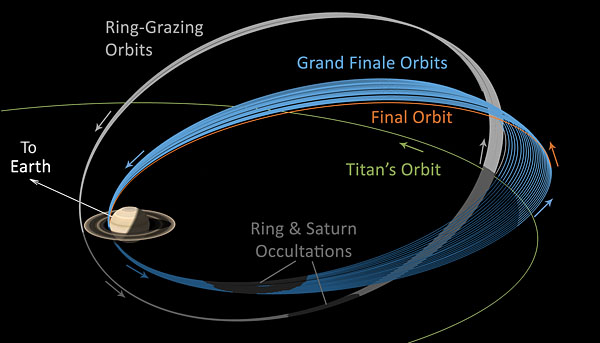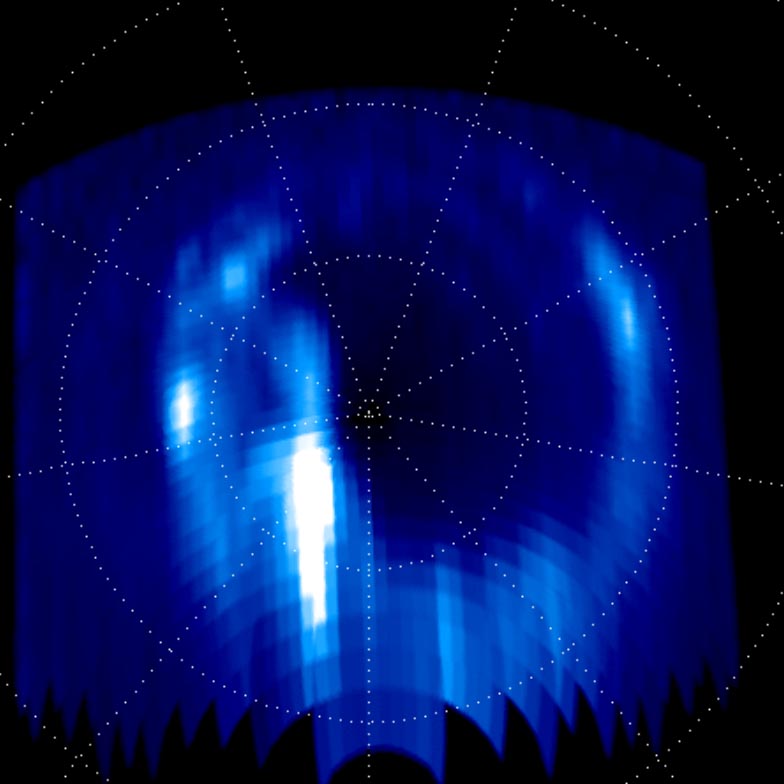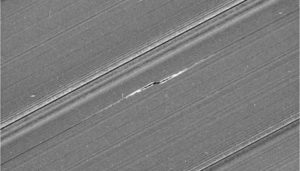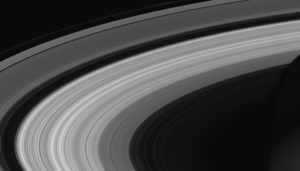You'd think scientists would have Saturn all figured out after watching it up close for 13 years. They don't.
When NASA's Cassini spacecraft eased into orbit around Saturn in July 2004, its "to-do" list spanned every aspect of the Saturn system. Yet some of the mission's most memorable moments were close encounters with the planet's vast system of moons — from a single brush with two-faced Iapetus to 127 close flybys of huge, murky Titan (which included delivering the European Space Agency's Huygens lander).
But during the spacecraft's last four months in residence, the scientific focus was almost exclusively on Saturn itself and the majestic, dramatic, complex ring system that surrounds it. This "grand finale" carried Cassini on 20 orbits that skimmed just outside the main ring system and 22 that threaded a corridor between the planet and the vestiges of its innermost ring.
During a meeting of the American Astronomical Society's Division for Planetary Sciences, held this week in Provo, Utah, a parade of Cassini scientists offered some of the insights they gained during this unprecedented scrutiny.

NASA / JPL-Caltech
Uncharted Territory
The final orbits sent the spacecraft dashing at 35 km (20 miles) per second north to south through a planet-ring gap about 2,400 km (1,500 miles) wide between the planet and the rings. But this region isn't truly empty — Cassini got a chance to directly sample the hydrogen and other compounds present in Saturn's uppermost atmosphere.
It's those "other compounds" that have planetary scientists scrambling for explanations. In theory, material is leaking from the innermost threads of the ring and drifting toward the planet, and generally the rings consist almost entirely of water ice. But investigator Mark Perry (Johns Hopkins University's Applied Physics Laboratory) reports that Cassini's Ion and Neutral Mass Spectrometer (INMS) found surprisingly little water in the planet-ring gap. That's partly due to water's tendency to stick to the tubing inside the INMS, Perry explains.

NASA / JPL / Univ. of Colorado / Univ. of Liege
Instead, the mass spectrometer swept up many heavier compounds that haven't yet been identified. For example, a peak with an atomic weight of 16 is most likely methane (CH4), a gas that shouldn't be percolating up from the atmosphere and would be chemically out of place in the the water-ice rings. Another peak at 28 could be carbon monoxide (CO) or molecular fragments of carbon-bearing dust particles. Confirming either of these will take more modeling to explain.
The close passes also allowed dynamicists to use tiny changes in Cassini's velocity to probe the planet's gravity field. As Michele Dougherty (Imperial College London) noted, this analysis is just getting started — but already it's raising questions about the state of Saturn's deep interior. One key question is whether the core is a distinct rocky mass or something more like the "fuzzy" dispersed core that Jupiter seems to have.
Meanwhile, Dougherty reports, Cassini got its best-ever chance to measure Saturn's magnetism. Earlier results had shown that the magnetic field was aligned closely with Saturn's spin axis, a unique arrangement in the solar system. But the close-in measurements now show that the axial alignment is incredibly close — to within about 0.06°. Saturn's magnetic dynamo likely occurs in a layer of metallic hydrogen deep inside the planet, but dynamo theory requires a tilt to generate a magnetic field.
"It’s almost as if you can use the magnetic field to see inside Saturn itself," she notes, adding that the situation "must be more involved than we thought." She expects more clarity to emerge in a few months, after data from all the Grand Finale orbits have been analyzed.
Ring Revelations

NASA / JPL / Space Science Inst.
Cassini's close-in flybys also gave mission scientists a chance to examine the rings in extreme detail. They'd gotten one other opportunity like this — when the spacecraft passed very close to the planet during its arrival in 2004. But the final orbits provided a chance to reexamine some curiosities more intensively.
Matthew Tiscareno (SETI Institute) delved into three of these at the meeting. He described new views of clumpy structure in the main rings (dubbed "straw") that Cassini had seen earlier. Tiscareno can't yet explain how or why this occurs — the higher-quality images show that the clumpiness doesn't correlate with the pattern of rings or with sets of gravitationally induced waves found in them.
Other ring oddities, known as "propellers," are local disturbances in the myriad particles created by embedded but unseen bodies that range in size from 100 meters to 1 km across. Swarms of these features cluster in A ring — many small ones lie in the middle of the A ring, while the largest are found in the outer A ring. Tiscareno explained that some propellers have been tracked throughout Cassini's mission, and the final images should allow him and others to deduce not only the embedded moons' masses but also the sizes and distribution of ring particles sweeping by them.

NASA / JPL / Space Science Inst.
Meanwhile, the ring system presents a huge yet delicate target for chunks of interplanetary debris up to a few meters across. When these strike the rings they create brief clouds of disrupted particles, and new images show lots of these splats. Tiscareno reports that color information in the Cassini images should give mission scientists a handle on the composition of the colliding objects.
As with any good space mission, Cassini has raised some important new questions. For example, because of the near-identical alignment of Saturn's magnetic and rotation axes, scientists have struggled to determine just how fast the planet spins. We can see the motions of its clouds, but the rotation rate of its deep interior is still uncertain.
Another question is whether Cassini's Grand Finale observations can pin down the total mass of Saturn's rings — critical to models of how and when they formed. Project scientist Linda Spilker (Jet Propulsion Laboratory) hinted that, based on the analysis so far, that mass might be less than expected. But, as with all of these preliminary results, the final answer is still months away.
 0
0









Comments
You must be logged in to post a comment.